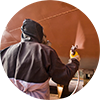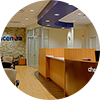
Facilities and Fatigue: Guidance for a Safe and Healthy Office Space
The Centers for Disease Control and Prevention (CDC) has made recommendations on how to prepare facilities for resuming business operations post-pandemic, such as ensuring ventilation systems are working well.1 But facilities aren’t all business leaders may wish to consider. Proactively addressing aspects of the office environment may help counteract employee fatigue and support health, safety, and productivity. These steps can be taken either as part of the post-pandemic transition back to the workplace or later. Fatigue was a $400 billion a year problem before the pandemic. Now, the Society for Human Resource Management (SHRM) says employers may also confront “COVID fatigue” as 70 percent of employees globally say the pandemic has been the most stressful 12 months of their lives.2
A building checkup of HVAC systems and potential hazards
In modern, airtight buildings, if ventilation is poor, employees may experience fatigue, difficulty concentrating, and a host of other symptoms, such as runny nose or nasal congestion, fever, cough, difficulty breathing, throat soreness or tightness, and headache. This is known as “building-related illness,” or disorders that affect the lungs, as well as other parts of the body, and are caused by exposure to substances within the building. This type of illness can occur in buildings where windows are sealed and circulation of air is provided entirely by heating, ventilation, and air conditioning (HVAC) systems.3 Understanding and being vigilant about building-related illness can help employers rule out their building’s systems as a cause if these symptoms start to appear among the workforce.
Since the pandemic began, from 56 to 70 percent of employees “always” or “sometimes” worked remotely.4 Consequently, many buildings were either shut down or minimally used for months.5 For these situations, the CDC provides a checklist to help assess if the building is ready for occupancy as business operations resume.6 Some of the steps the CDC recommends for building employers, owners, and managers are:
- Evaluate building mechanical systems. Ensure ventilation systems, as well as heating and air conditioning systems, are operating properly. If HVAC systems have been shut down, you may need to consult the standard practice guidelines for the inspection and maintenance of commercial building HVAC systems, approved by the American Society of Heating, Refrigerating, and Air-Conditioning Engineers (ASHRAE), the Air Conditioning Contractors of America (ACCA), and the American National Standards Institute (ANSI).
- Check for hazards associated with prolonged facility shutdown, such as mold, pests, and stagnant water problems, and remediate any issues that could affect employee health.
- If possible, increase circulation of outdoor air, unless there is a high risk of outdoor contaminants, such as mold, pollen, or carbon monoxide.
The pandemic has increased general awareness and concern about virus spread, so this may be a good time to consider investing in high-efficiency particulate air (HEPA) fans or filtration systems that improve the cleanliness of the air. Air cleaning and filtration systems are designed to filter out pollutants, and they can “reduce airborne contaminants, including viruses,” but alone, they are “not enough to protect people from COVID-19.” Still, when used along with the CDC’s best practices for COVID-19 protection, these systems “can be part of a plan to reduce the potential for airborne transmission of COVID-19 indoors” as well as keep the air cleaner generally, says the Environmental Protection Agency.7
Steps employees and employers can take against fatigue
Nearly every employee is at risk for fatigue, says the National Safety Council (NSC).8 Fatigue – feeling tired, requiring more energy and effort to perform tasks, and difficulty thinking or reacting quickly – may decrease productivity and increase the risk of injuries, according to the NSC.9 In April 2021, a Concentra article addressed fatigue in construction, transportation, manufacturing, and the oil and gas industry. But what about office employees? They get sleepy, too, and may even arrive at work already fatigued. By instinct, some of these employees may have learned that quick, five-minute “microbreaks” throughout the day helps them manage their energy resources to stay productive on days when they’re tired, according to North Carolina State University research.10,11
Avoiding fatigue altogether may be a better alternative for most employees. As a component of a workplace wellness initiative, employers can encourage employees to practice good sleep hygiene, as described by the American Academy of Sleep Medicine (AASM).12 Here are some examples from an AASM tip sheet:
- Create a regular schedule for sufficient sleep and regular meal and exercise times. At least seven hours of sleep every 24 hours is recommended, although some people need more to feel fully restored. Take a short power nap if getting seven or more hours of sleep is impossible.
- About 30 to 60 minutes before bedtime, engage in relaxing activities, such as reading, meditation, or soothing music. Avoid the stimulation of heavy exercise, bright lights, or disturbing images or content.
- Avoid excessive alcohol or caffeine close to bedtime. Alcohol should not be consumed within three hours of bedtime.
- Create a dark, quiet environment for sleep. Remove clutter, cover windows, and turn off electronic devices.
- Banking sleep (up to 10 hours) on days off may help reduce performance impairment on a subsequent day when adequate sleep is not possible.
- Use tools like checklists and cross-checking procedures with colleagues to reduce fatigue-related errors.
Fatigue is a well-known, work-related problem, so employers should put employees at ease about reporting any incidents or close calls due to fatigue. The CDC says taking steps early to mitigate fatigue can help avoid more serious errors or injuries later.13
Aspects of the work environment that can be addressed to decrease or counteract fatigue include:
- Work design and group interaction
- Low-level noise
- Work station type
Let’s look at what research says about each of these factors.
Work design and group interaction. Employees who shoulder a heavy workload – either in reality or based on their perceptions – need time to recover. The need for recovery time is correlated with fatigue and fatigue-related job accidents, according to research published in the Journal of Occupational and Environmental Medicine.14 Although the study, published in December 2020, specifically examined how drivers perceive workload and psychological strain (with need for recovery), the notion is interesting to consider for office employees, too. Researchers found that allowing time for quality group interaction lessened the need for recovery time from a heavy workload and decreased psychological strain/fatigue and incidence of job accidents. A high-intensity office without breaks may be counterproductive by fostering fatigue and accidents.
Low-level noise. Office noises such as phones ringing at unoccupied desks, coworkers talking at an outdoor pitch, machines running non-stop, or construction activity not only decrease productivity but may also pose a health risk for employees. Noise can increase stress and, according to a University of Michigan study, also cause blood pressure and heart rate to soar. Some employees may become moody or irritable due to noise.15 Among the available solutions to help employees block out noise are headphones, carpeting and rugs instead of concrete or tile flooring, and private spaces for phone calls and quiet work rather than full utilization of open office space design.16,17 Disenchantment with the open office space design – a trend adopted in 70 percent of offices by 2017 – has fueled interest in anechoic chambers or quiet “office pods” for better concentration and productivity when interaction with others is not needed.18
Workstation type. In March 2021, the Journal of Occupational and Environmental Medicine published research that explored workstation design and three health metrics: physical activity, stress, and sleep quality. Data showed that when workstation design promoted physical activity, sleep quality and stress levels were better than with the more sedentary nature of private offices and cubicles.19 Office settings with lower physical activity are associated with poorer health outcomes that cost the annual economy $225 billion.20
Conclusion
Concentra is a leader in occupational health and can help employers navigate the challenges of fatigue in the workplace. Maja Jurisic, MD, CPE, Concentra vice president and medical director of strategic accounts, has addressed the effects of shift work on sleep deprivation and fatigue. Michael Berneking, MD, FACOEM, FAAFP, FAASM, Concentra medical director, was recently featured in Risk&Insurance on the hazards of fatigue and driving accidents. In a Concentra article, Anne-Marie Puricelli, MD, JD, Concentra national medical director of transportation highlighted why employers’ giving attention to fatigue now is more important than ever.
Take a closer look at Concentra’s occupational health services that can help not only tackle fatigue but support better workforce health overall.
NOTES
- COVID-19 Employer Information for Office Buildings. Centers for Disease Control and Prevention. April 7, 2021.
- “One Year into the Pandemic, COVID-19 Fatigue Takes Hold.” Society for Human Resource Management. February 27, 2021.
- Building-Related Illnesses. Merck Manual. Consumer Version. May 2020.
- “Poll: Americans Like Working at Home.” U.S. News & World Report. February 12, 2021.
- “Awakening.” NFPA Journal. Summer 2021.
- COVID-19 Employer Information for Office Buildings.
- Air Cleaners, HVAC Filers, and Coronavirus (COVID-19). Environmental Protection Agency.
- NSC Fatigue Reports. National Safety Council.
- Ibid.
- "Tired at the office? Take a quick break; your work will benefit.” ScienceDaily. March 16, 2021.
- Kim S, Cho S., Park Y. “Daily microbreaks in a self-regulatory resource lens: Perceived health climate as a contextual moderator via microbreak autonomy.” Applied Psychology. April 2021; 106(4)
- Prioritizing Sleep and Managing Fatigue. The American Academy of Sleep Medicine. 2021.
- What Workers and Employers Can Do to Manage Workplace Fatigue during COVID-19. Centers for Disease Control and Prevention. May 19, 2020.
- Kao FH, Kuo CC. The Safety of Drivers: Workload, Group Interaction Quality, and Psychological Strain. Journal of Occupational and Environmental Medicine. December 2020; 62(12): 1069-1075.
- “The Effects of Noise in the Workplace.” San Francisco Chronicle.
- Ibid.
- “Interface Study Reveals Impact of Noise on Workplace Productivity.” I and S Design. May 14, 2019.
- “Can ‘Pods’ Bring Quiet to the Noisy Open Office?” Bloomberg. July 2, 2019.
- Goel R, Pham A, Nguyen H, et al. Effect of Workstation Type on the Relationship between Fatigue, Physical Activity, Stress, and Sleep. Journal of Occupational and Environmental Medicine. March 2021; 63(3): e103-e110.
- “Yet another open office study proclaims the benefits of the format.” HR Dive. August 23, 2018.



